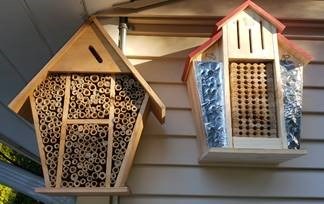It's officially mason bee season and it's time to get last year's bee cocoons out or buy a bunch. I hung my mason bee house outside in a covered southerly exposed location and within a couple hours I already had a half a dozen males out and circulating around their bee house. For those of you who are not are 100 per cent mason bee aficionados (I am not), mason bees are very easy to take care of and the most beneficial. There are no “workers” in solitary bee life there are only the females and males. Only females have stingers, but you literally have to grab one and squeeze it for it to sting you. They’re solitary bees, and earn their name because they make mud homes in cracks or holes in wood, stone, the ground or a wooden nest if you provide it. Before honey bees arrived from Europe, native bees, like masons, did 100 per cent of the pollination. Mason bees are not particular about the flowers they harvest pollen from as they pollinate everything in their path, in fact one mason bee can pollinate as much as 100 honeybees. So having a couple dozen masons in your yard will give you the equivalent of a fair sized honey bee colony. So with the warmth of this spring, you’ll see these little pollinating dynamos arise to make your garden its most successful by far.
Go Green Pest Control owner Randy Bilesky is a long-time South Delta resident. Trained and certified, Bilesky has first-hand knowledge of the pest problems that local homeowners and business owners encounter.


